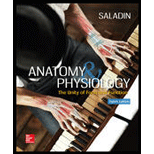
Beavers have relatively little need to conserve water and could therefore be expected to have _______ than humans do.
a. fewer nephrons
b. longer nephron loops
c. shorter nephron loops
d. longer collecting ducts
e. longer convoluted tubules
Introduction:
The kidney’s structural unit is nephrons. Glomeruli are a network of capillaries that help in blood filtration. This yields filtered water and soluble substances into a cup-like sac called the Bowman’s capsule. Glomerulus is supported structurally by glomerular mesangial cells.
Answer to Problem 9TYR
Correct answer:
Beavers have relatively little need to conserve water and could therefore be expected to have shorter nephron loops than humans do. Therefore, option c is correct.
Explanation of Solution
Justify reasons for the correct statement:
Animals that are in need to preserve water have numerous and lengthier nephron loops compared to the other animals with a slight need to conserve water.
Option (c) is given as “shorter nephron loop”.
Due to the absence of a nephron loop, the amphibians and fish produce urine that is isotonic to their blood plasma. For example, beavers, which are aquatic mammals, have smaller nephron loops, and thus the conservation of water is less.
Hence, option (c) is correct.
Justify reasons for the incorrect statements:
Option (a) is given as “fewer nephrons”.
Humans can survive with few nephrons, but the output of urine will be only 30mL per hour. Inadequate nephrons will lead to uremia. Hence, it is a wrong answer.
Option (b) is given as “longer nephron loops”.
The longer length of the loop helps in more reabsorption of salts in the medulla and increases more the volume of water to be absorbed. Hence, it is a wrong answer.
Option (d) is given as “longer collecting ducts”.
The longer collecting duct aids in making the urine more concentrated by absorbing more volume water in the medulla. Hence, it is a wrong answer.
Option (e) is given as “longer convoluted tubules”.
The proximal convoluted tubule is the longest of the convoluted tubules, and its major purpose is absorption. Hence, it is a wrong answer.
Hence, options (a), (b), (d), and (e) are incorrect.
The beavers normally have a shorter nephron loop because there is no need for water conservation, as they are aquatic mammals.
Want to see more full solutions like this?
Chapter 23 Solutions
Anatomy & Physiology: The Unity of Form and Function
Additional Science Textbook Solutions
LooseLeaf for Integrated Principles of Zoology
Laboratory Experiments in Microbiology (11th Edition)
Human Anatomy & Physiology
Human Anatomy & Physiology (2nd Edition)
BIOLOGY:THE ESSENTIALS (LL) W/CONNECT
- Which nephron structure is often longer in animals adapted to desert environments? a. Glomerulus b. Bowman's capsule c. Distal and Proximal tubules d. Loop of Henlearrow_forwardMarine reptiles eliminate excess salt bya. transport across their gills.b. excretion through salt glands.c. reabsorption in the nephron tubules.d. excretion through the cloaca.arrow_forwardMost of the water reabsorption in the nephron is done by ? A) proximal tubules B) loop of henle C) distal tubules D) collecting ductarrow_forward
- Kangaroo rats are small rodents that live in the desert of the southwest United States. Their kidneys produce urine that is much more concentrated than the typical urine of mammals. Which statement best explains the evolution of the kidneys of the kangaroo rat? a. The kidneys are adaptations for the desert environment, where organisms benefit by conserving water in their bodies. b. The kidneys are adaptations for the small size of the kangaroo rat, which is not able to hold a large volume of urine. c. The kidneys are the same as all other mammalian kidneys, but function differently in the desert environment. d. The kidneys were adapted for life in the ocean, and then retained their function when kangaroo rats moved to land.arrow_forwardFreshwater fish tend to have larger swim bladders than saltwater fish. Explain why you would expect this to be true.arrow_forwardThe compact ball of capillaries in a nephron is called:- a. the nephron loop. b. the peritubular plexus. c. the renal corpuscle. d. the glomerulus. e. the vasa recta.arrow_forward
- In which part of the nephron parts is no water reabsorbed? a) The downward part of Henles is slung b) The upward part of Henles is slung c) Distal tubules d) Distal tubulesarrow_forwardThe kidneys bladder and ureters make up the? arrow_forwardwhy would you expect an animal that lives in fresh water to have a well developed excretory systemarrow_forward
- You are studying renal function in different species of mammals that are found in very different environments. You look at species from a desert environment and compare them with ones from a tropical environment. The desert species would be expected to havea. shorter loops of Henle than the tropical species.b. longer loops of Henle than the tropical species.c. shorter proximal convoluted tubules than the tropical species.d. longer distal convoluted tubules than the tropical species.arrow_forwardIn reptiles, distal collecting tubules merge to form collecting ducts, which ultimately form the ____. a. ureter b. urodeum c. cloaca d. renal veinarrow_forwardMention the function of the following(a) Ureters in frog(b) Malpighian tubules(c) Body wall in earthwormarrow_forward

